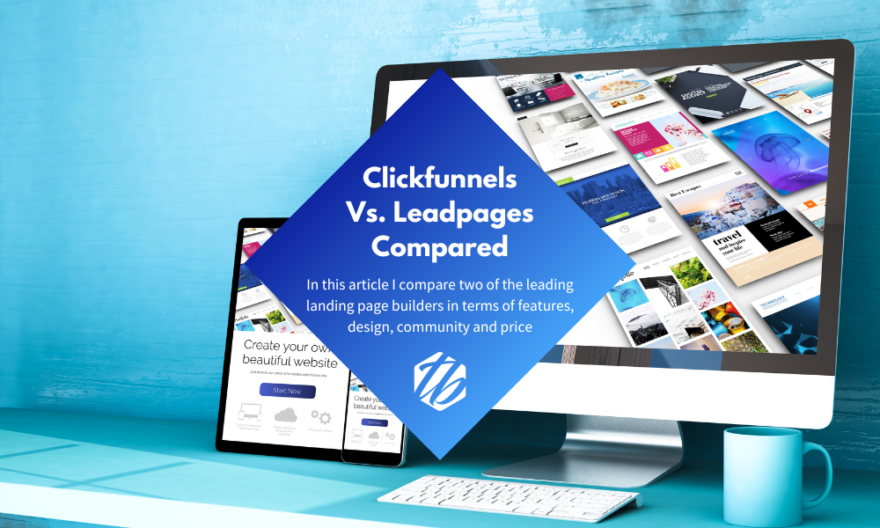If you want to generate leads, get sales and grow your business in the digital age, having a landing page builder and sales funnel software is mission critical. If there were a duel between Clickfunnels vs Leadpages, which software would win?
Let’s find out and pick the ultimate winner.
There are tons of different landing page builders and sales funnel software available. Finding out which one is the right fit for you can be challenging given the overwhelming amount of choice.
In this article I’ll compare these two platforms based on their page editor, templates, functionality and community.
Let’s dive in.
Disclosure: Some of the links in this article may be affiliate links, which can provide compensation to me at no cost to you if you decide to purchase a paid plan. These are products I’ve personally used and stand behind. This site is not intended to provide financial advice and is for entertainment only.
Clickfunnels vs Leadpages: Overview
Before we get into the nitty-gritty of the comparison, let’s look at the main differences between the two tools.
Clickfunnels:
Clickfunnels is a landing page builder and sales funnel software that allows you to build websites, landing pages, email capture pages, checkout pages and entire sales funnels.
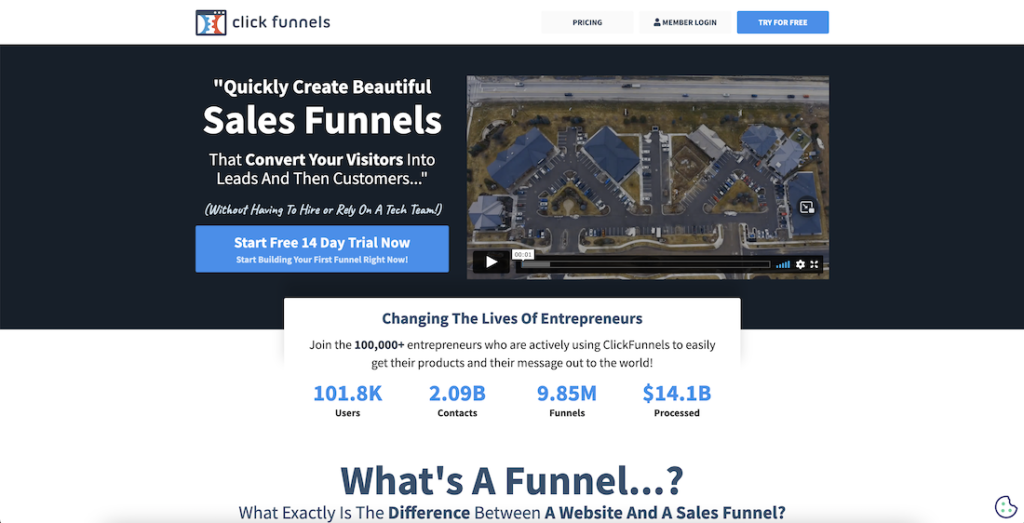
The premium plan also comes with a full-fledged affiliate management tool and email marketing platform. In this sense, you can think of Clickfunnels as an all-in-one marketing platform for your businesses.
A lot of my clients and people I know in the marketing community use Clickfunnels and Clickfunnels only. This means they don’t need another tool to manage their affiliates, collect emails or send out newsletters and marketing emails.
Key features:
- Drag-and-drop page editor
- Email capture pages to build your email list
- Checkout pages to collect payments
- Build websites
- Build entire sales funnels
- Automated webinars
- Email database
- Send email broadcasts, automated follow ups and confirmation emails
- Create popups and alert bars
- Easy A/B testing
- Awards & live events
- Share funnel and import functionality
- Funnel marketplace
- Thriving community
- Host downloadable files
Leadpages:
Leadpages is a landing page and website builder that lets you create websites, landing pages, email capture pages and checkout pages.
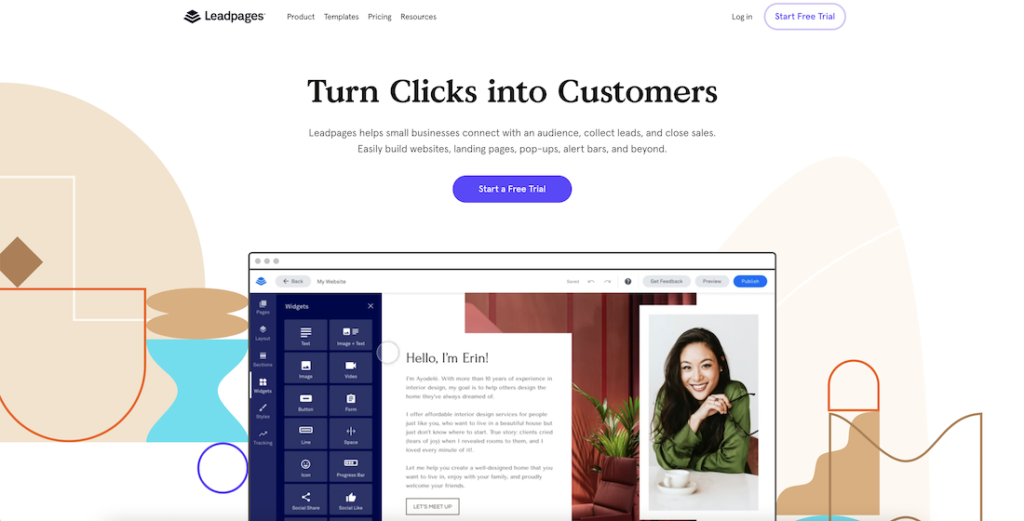
Additionally to this, you can also create popups and alerts.
While Clickfunnels is more of an all-in-one marketing tool that allows you to build sales funnels, manage affiliates, keep track of contacts and send out emails, Leadpages is best suited for building static websites and landing pages.
Key features:
- Drag-and-drop page editor
- Email capture pages to build your email list
- Checkout pages to collect payments
- Build websites
- Email database
- Create popups and alert bars
- Easy A/B testing
- Leadmeter
- Expert Feedback
- Host downloadable files
- 40+ standard integrations
- 1-on-1 quick start call
- Lead notifications
Clickfunnels vs Leadpages: Detailed Breakdown
1. Page Editor.
Since I’m comparing two landing page builders, let’s start by looking at the page building and editing experience using both tools.
This is where you’ll spend most of your time, so the page editor should be user-friendly, simple and intuitive.
Clickfunnels:
The Clickfunnels page editor is extremely easy to navigate. It’s almost as if you’re able to just type on the screen. You can drag elements around, change colors, add buttons and pretty much customize any part of the page.
You can add new sections, rows and elements easily.
There’s the option to toggle between mobile and desktop view and customize your page for each layout.
And you can quickly preview your page in real-life in a new window.
When Clickfunnels released its first page editor back around 2014, it was truly revolutionary.
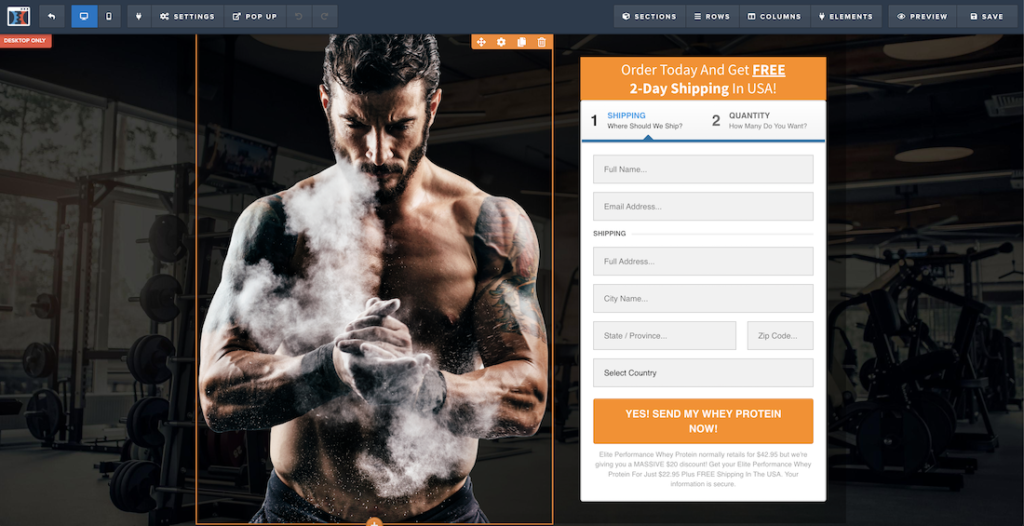
I remember vividly because I was a Leadpages customer at a time.
Back then, Leadpages had replaced an old and outdated WordPress tool called “Optimizepress”. Everyone in the marketing community switched over to Leadpages due to the easy and improved way of building landing pages.
But shortly after, Clickfunnels came out which had a much less bulky and more intuitive page editor.
This is the main reason I switched from Leadpages to Clickfunnels slightly less than ten years ago.
Clickfunnels vs Leadpages: Why Did I Make the Switch?
At the time, the Leadpages page editor was bulky. You couldn’t just edit headlines and text by clicking on it and starting to type. When you clicked on an element, a sidebar opened which contained an option to edit the text.
This greatly slowed down the page editing process and made it more cumbersome to build a page.
Furthermore, Leadpages had relatively fixed templates. You could change text, swap out images, adjust colors and do some other things, but you couldn’t customize how the page looked and make it your own.
Everything was very templated on Leadpages while Clickfunnels was very customizable.
However, one downside of Clickfunnels is that I’ve come across the occasional bug. Once I tried to click on the “undo” change button and it undid everything, not just the last step.
And occasionally I run into a visual or design glitch that I need to fix by duplicating the page or saving individual elements and continuing the editing process in a new window.
Despite these occasional bugs, I still love Clickfunnels’ fast, intuitive and fully-customizable page editor.
But how does Leadpages fair against Clickfunnels today in terms of its page editor?
Let’s have a closer look.
Leadpages:
Leadpages has improved quite a lot, I must say.
To write this article I signed up with Leadpages again to see how far they came in the last 8 years.
I’m delighted to report that you can now edit headlines and text directly on screen without first having to open a sidebar.
This removes an extra step and speeds up the page building process.
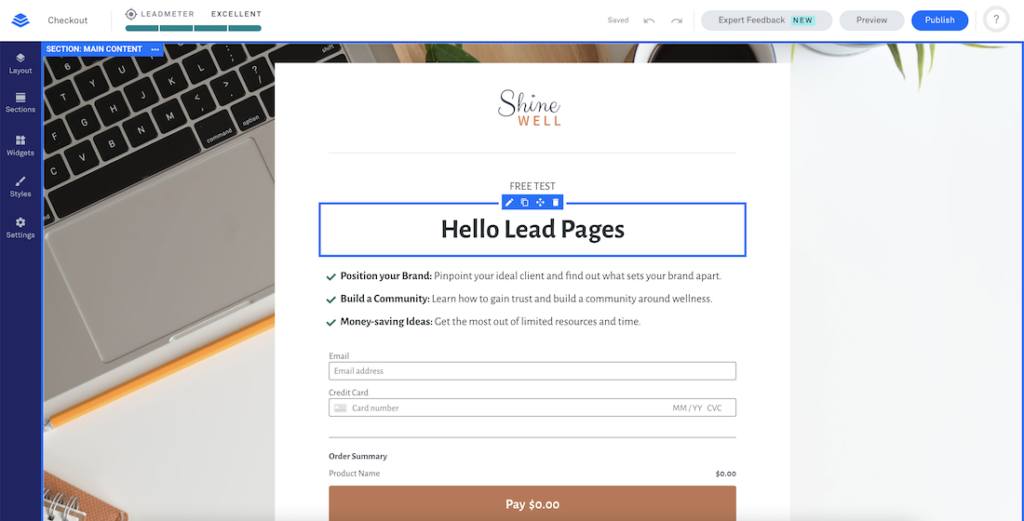
Despite this, I encountered a few issues with the page builder.
Some things didn’t seem to work. I tried to change the image on my test landing page but nothing happened when I clicked on it. I also noticed some other functionality was missing which was strange.
After a few minutes I disabled my ad blocker and everything worked again.
However, I was a bit put off by the fact that I had to disable my ad blocker to use Leadpages’ page editor.
When I tried to preview the page, it took quite a long time to load. I had to enter and exit “Preview” mode to see what the page looks like. In Clickfunnels you can just click preview and it opens the page in a new window.
There is no “Preview” mode in Clickfunnels, which means you can check what your page looks like a lot faster. Overall, LeadPages’ page editor, while it improved a lot, is still more bulky and less customizable than the native page editor you’ll find in Clickfunnels.
Even though Clickfunnels’ page editor suffers from the occasional bug, the moment I used Leadpages with my ad blocker on the entire editor broke.
This makes me believe that if I were to use the editor for another 10-20 hours, I would likely experience another bug or problem.
After playing around with the page editor for a while, I have to say they definitely improved a lot in the last years. But even today, I believe Clickfunnels wins hands down as the easier and more intuitive page builder.
Winner: Clickfunnels.
2. Basic Functionality.
Now that we compared at the most important functionality, the page builder, let’s take a look at the basic functionality. Clickfunnels vs Leadpages: Who wins when it comes to overall features in the basic plan?
That’s what I’m about to take a close look at, so buckle up.
Clickfunnels:
Clickfunnels and Leadpages both have a basic version and an advanced version.
The basic version of Clickfunnels includes the following things:
- 20 funnels
- 100 pages
- 20,000 monthly visits
- Unlimited contacts
- 1 sub user
- 3 custom domains
- 3 payment gateways
- Email support
- FunnelFlix
I personally used the basic version of Clickfunnels for almost 8 years and never had to upgrade. However, I had to pay for other tools to manage affiliates and send out broadcasts and automated emails to my list.
Occasionally I maxed out the number of funnels or pages allowed in my account, but I quickly fixed this by archiving an old funnel I didn’t need anymore.
The most important thing that stands out is that Clickfunnels isn’t just a landing page builder. It’s an entire sales funnel builder.
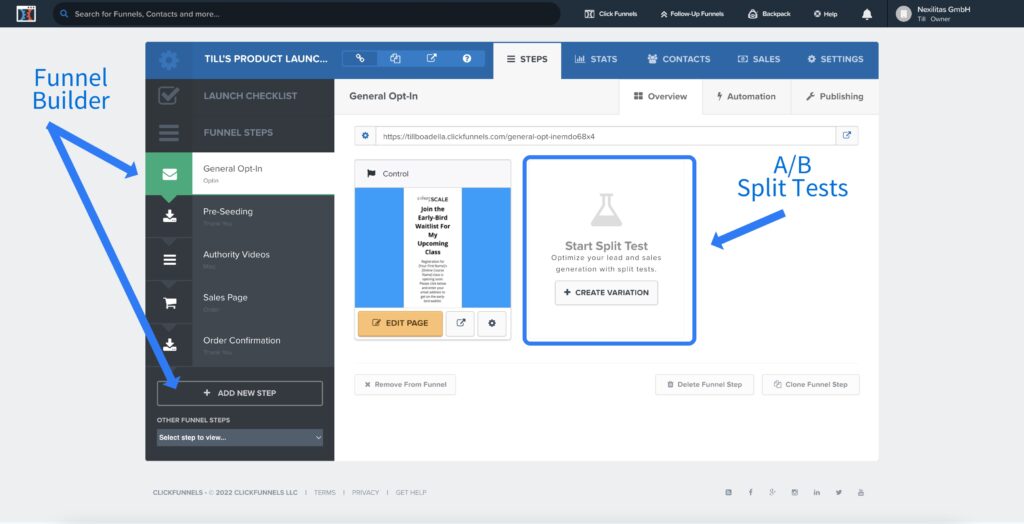
You can add 1-click upsells and down-sells after your checkout page and “stack pages” on top of each other to create a unique marketing funnel.
This, combined with the customizable and intuitive page editor, is what makes Clickfunnels great in my opinion.
Leadpages:
Let’s take a look at what’s included in the basic version of Leadpages for a fair comparison.
The basic version of Leadpages includes the following things:
- 1 site
- Landing pages, pop-ups, alert bars
- Unlimited traffic & leads
- Free hosting
- Mobile-responsive site templates
- Lead notifications
- Tech support via email
- 40+ standard integrations
- 1-on-1 quick start call
Some of these things weren’t even listed in the list of Clickfunnels features.
But it’s important to note that landing pages and pop-ups, unlimited leads, free hosting, mobile responsiveness, lead notifications, online sales and payments and A/B split testing or all included in Clickfunnels’ basic plan.
Leadpages basic plan doesn’t include A/B split tests, online payments and checkout pages.
Comparing Limitations & Account Restrictions
The main thing that stands out is that you get unlimited traffic with the basic Leadpages plan, whereas you’re limited to 20,000 with Clickfunnels. However, it’s important to understand that 20,000 is a lot of traffic.
If you’re getting this much traffic to your landing pages and funnels, you are probably already running a six-figure or seven-figure online business. So upgrading to Clickfunnels’ platinum plan for unlimited traffic wouldn’t really be a significant expense at that point.
The second thing that stands out to me is the 1-on-1 quick start call. Now, I personally never make use of such calls but I’m not sure if Clickfunnels offers a set up call of this sort.
So I’d say that’s a point for Leadpages.
You can also build one full-fledged website with Leadpages, but have unlimited landing pages from what I can see. This means, Leadpages basic plan has slightly less limitations than Clickfunnels.
But on Clickfunnels’ basic plan you get significantly more features than with Leadpages because it’s not just a landing page builder but a full sales funnel builder. It includes A/B split testing, online payments and checkout forms in the basic plan which for me personally is one of the most important features.
After all, I want to make money and sell stuff and not just collect emails.
Clickfunnels vs Leadpages? This round goes to Clickfunnels.
Winner: Clickfunnels
3. Advanced Functionality.
You get an idea for the functionality included in the basic plans for Leadpages and Clickfunnels, so next up we’ll look at what’s included in their advanced plans.
Inside of Clickfunnels, the advanced plan is called “Clickfunnels Platinum”.
Leadpages named its advanced plan “Pro”.
Clickfunnels:
Let’s start again by looking at the features and functionality included in Clickfunnels Platinum.
Clickfunnels Platinum includes:
- Unlimited funnels
- Unlimited pages
- Unlimited monthly visits
- Unlimited contacts
- 3 sub users
- 9 custom domains
- 9 payment gateways
- Priority support
- FunnelFlix Platinum
- Follow-Up Funnels
- Weekly Hackathons
- Backpack Affiliate Management
Let’s unpack this.
The unlimited funnels, pages and monthly visits are self-explanatory. If you ever surpass the 20,000 visits per month allowed on the basic plan or need more than 20 sales funnels or 100 pages, you can just upgrade to the platinum version where everything is unlimited.
I personally was reluctant to do so for almost 8 years but recently switched to Clickfunnels Platinum and am not regretting it.
The main two things to highlight is that Follow-Up Funnels is actually an entire email marketing platform. I think the name wasn’t chosen wisely, it should rather be called “Email Marketing Platform”.
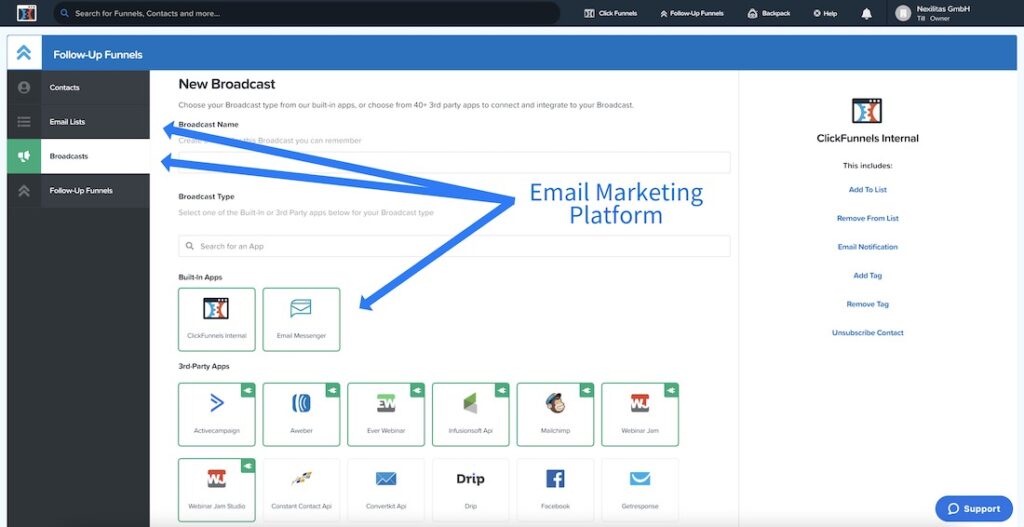
With Clickfunnels Platinum you can not only collect email subscribers but you can send newsletters and follow ups to your lists, segment your list with tags and view recent purchasing behavior and activity for each contact.
This basically makes it unnecessary to use a third-party email tool like Mailchimp, Convertkit or ActiveCampaign.
Backpack is the in-house affiliate management software that comes with Clickfunnels Platinum. This means, you can recruit affiliates, give them a unique tracking link and ask them to promote your landing pages and sales funnels.
Whenever they refer you a customer or client, Backpack tracks the sale and you can pay out an agreed-upon commission to your affiliate partner.
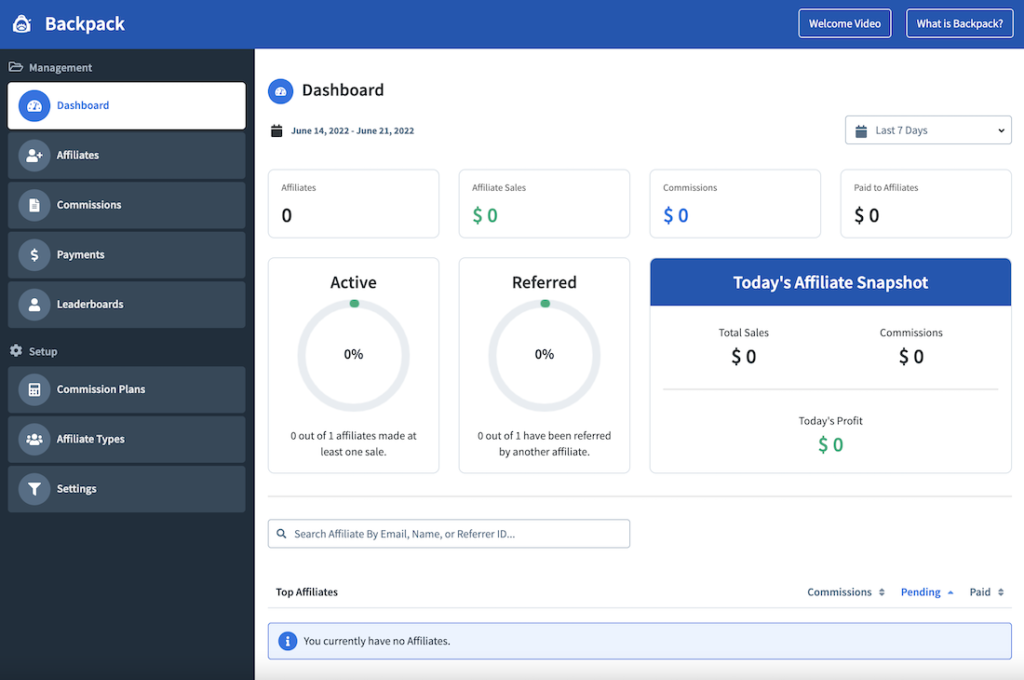
This is why I mentioned at the beginning of this article that Clickfunnels is more of an all-in one marketing platform.
Leadpages:
Now let’s take a look at the “Pro” plan within Leadpages:
Leadpages Pro includes:
- 3 sites
- Landing pages, pop-ups, alert banners
- Unlimited traffic and leads
- Free hosting
- Mobile-responsive site templates
- Lead notifications
- Priority support via phone, chat and email
- 40+ standard integrations
- 1-on-1 quick start call
- Online sales & payments
- Unlimited A/B split testing
The main additional features you get with Leadpages Pro is the ability to process online payments and create checkout forms and pages.
The second important feature that you get with Leadpages Pro is the ability for A/B split testing.
Personally, I believe the A/B split testing feature is overrated both in Clickfunnels and Leadpages. In almost 10 years of doing marketing online, I’ve rarely ever done any split testing and most people I know don’t either.
The ability to conduct A/B split-tests is awesome, but this type of nitty-gritty fine-tuning isn’t what’s really going to grow your business. It’s about getting your product and market fit right.
Split testing usually only makes sense for very high-volume sites.
However, the ability to process sales and host checkout pages is super important. Without the ability to collect payments, you don’t really have a business.
Clickfunnels vs Leadpages: Important Considerations
The basic version of Leadpages is more of a list building tool while the pro version is necessary to use Leadpages to make actual money. But even in the Pro plan of Leadpages, you don’t have the ability to build fully customized and complex sales funnels with 1-click upsells and downsells.
So if you want to sell stuff online, a basic Clickfunnels plan comes with more features and functionality to sell products and services than Leadpages Pro.
There are two cool features I want to point out that Clickfunnels doesn’t have though.
Leadpages has a “Leadmeter” that measures how optimized your landing page is. It sort of acts like a checklist to make sure you’re not doing something on your page that could backfire or harm your conversions.
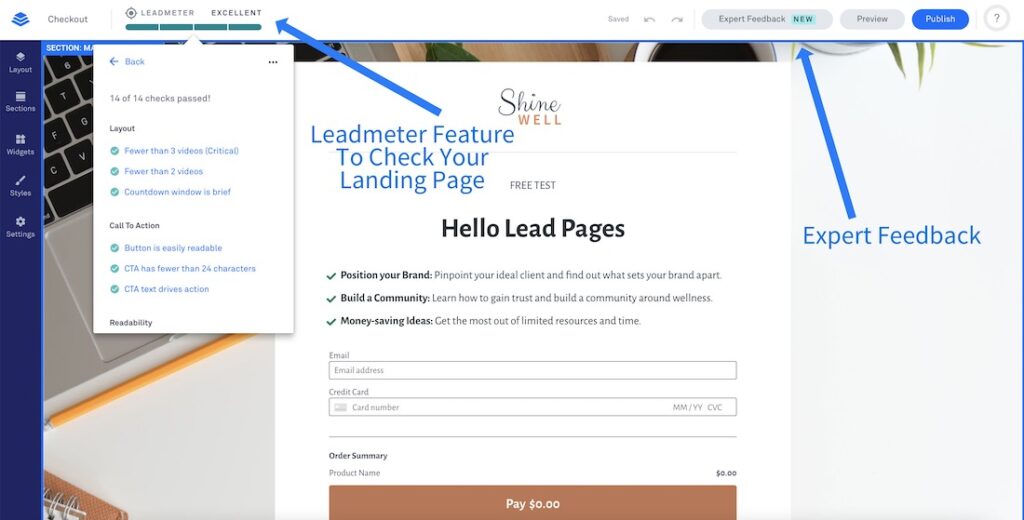
If you have a high score on the Leadmeter, your landing page doesn’t have any major flaws. If you have a low score, you can see what’s causing it and fix it.
I thought that was a cool feature.
Secondly, Leadpages allows you to get expert feedback for your landing page. If you want to get a second set of eyes to review your page before you go live, make use of this feature. When I checked, it was free but I suspect it will become a paid “add on” soon.
Funnel Sharing & Marketplace
On the other hand, Clickfunnels has two very important features that Leadpages seems to be missing.
- Funnel share ability
- Marketplace
With Clickfunnels you can easily share funnels with third parties. These third parties can then import the shared funnel and have it fully set up and cloned inside their account without having to rebuild it.
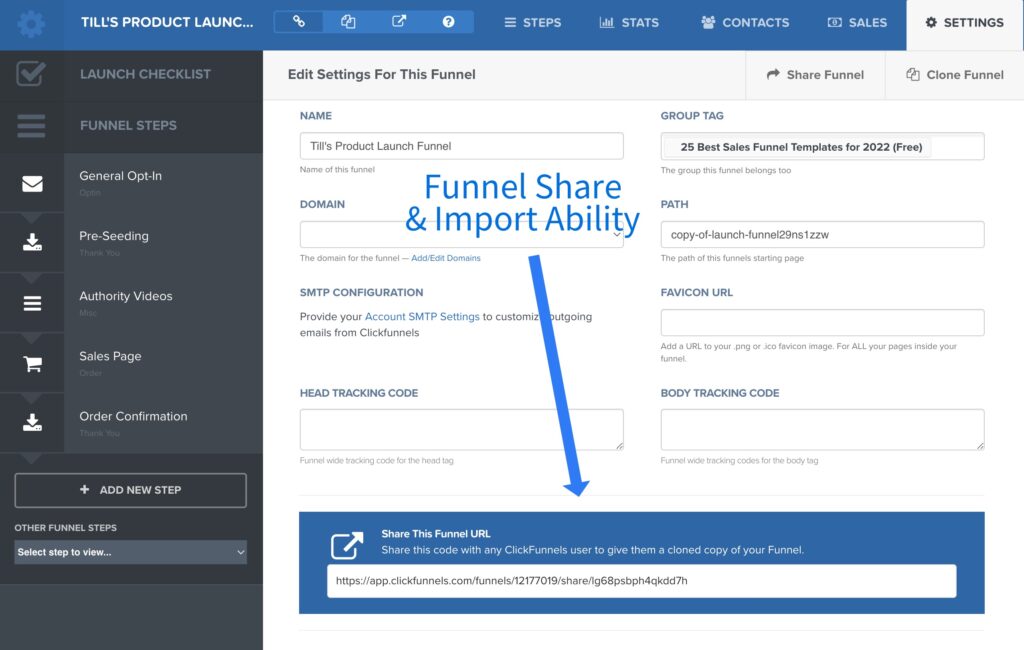
This is an incredibly cool and important feature.
(Hint: You can get some of my highest-converting sales funnel templates for free and even five done for you sales funnels with ad copy examples and email swipes).
Clickfunnels allows me to easily share entire sales funnels or individual page templates with clients, or with you.
The second thing that I like about Clickfunnels is that there is a third-party marketplace where you can purchase templates from funnel designers and third-party sellers. I don’t use this feature frequently, but I appreciate the fact that it exists.
Clickfunnels and Leadpages both have a host of templates that come along with the tool, but from what I can tell only Clickfunnels has a third-party marketplace where you can purchase designs from sellers.
The share funnel ability and marketplace stand out. While I can live without the third-party marketplace, I couldn’t live without the ability to share and import funnels with a click.
This is a huge point for Clickfunnels.
Winner: Clickfunnels.
4. Template Selection & Designs.
The next important thing we’ll look at is the selection of templates and the quality of the designs.
Obviously, design is an important consideration. Who wins in terms of template selection and design in this epic battle between Clickfunnels vs Leadpages?
Let’s find out.
Clickfunnels:
Clickfunnels used to have pretty poorly designed templates to be honest, but this was offset by the ability to customize templates and create completely custom pages and templates from scratch.
A while ago Clickfunnels revamped its available sales funnel templates which was a major improvement. They introduced their mother funnel series, among others, which are really good looking and I’ve used for my own funnels in the past.
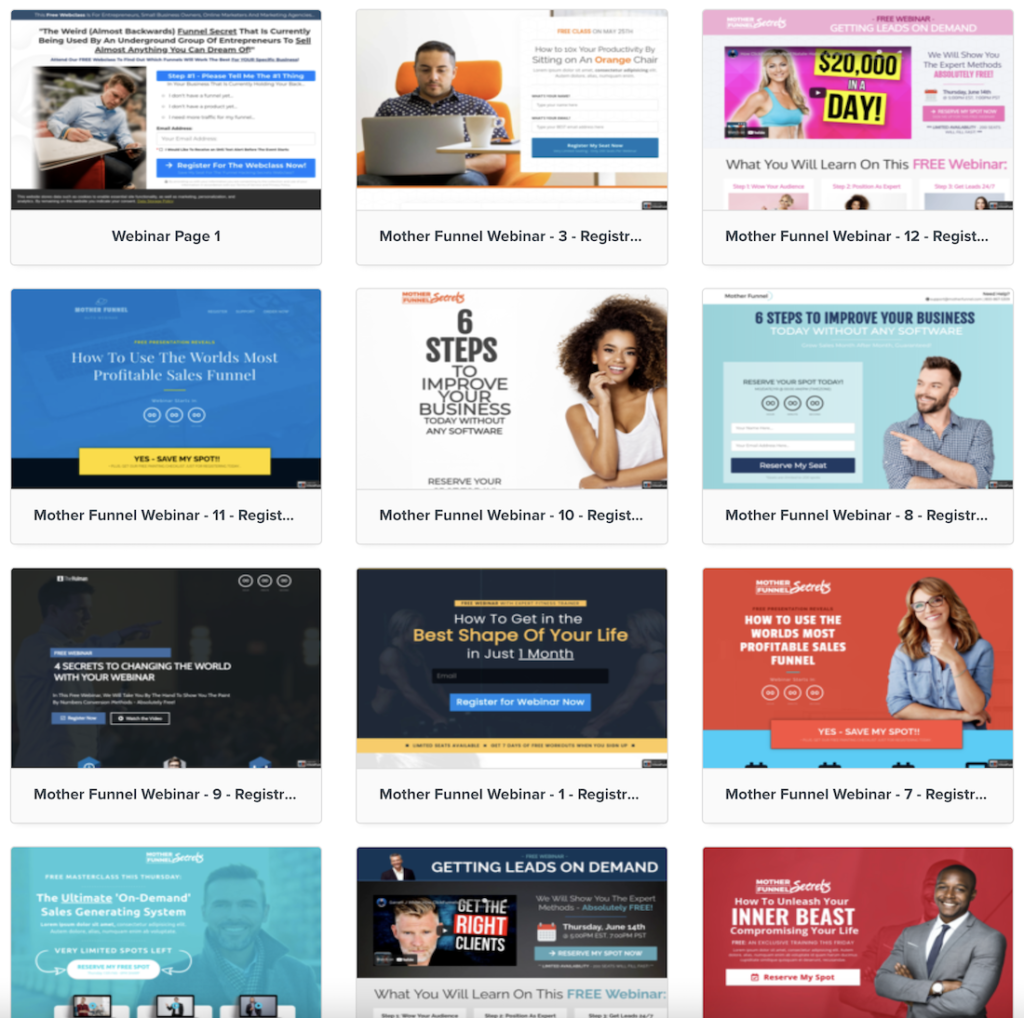
However, even the revamped designs have something unclean and messy about them.
This was never really a deal breaker for me though.
In fact, in some cases there seems to be an inverse relationship between beauty and conversions. I’ve found that my highest-converting funnels were often the simplest and ugliest ones.
And if I look at the most successful websites online, Google, Amazon, Wikipedia, CraigsList, ugly seems to work.
I prefer clean and beautiful templates from a personal standpoint, but I’m at a point where I much more care whether a site converts rather than whether it wins a design award.
Why is that the case by the way?
I think if something looks overly shiny and beautiful it can distract from the message and ultimately from the action you want someone to take on your website.
Leadpages:
Leadpages always had cleaner and better looking designs, even back in 2014.
This hasn’t changed. If anything, the templates Leadpages has available have improved since then. It’s clear that they place more emphasis on design and templates than features and overall functionality.
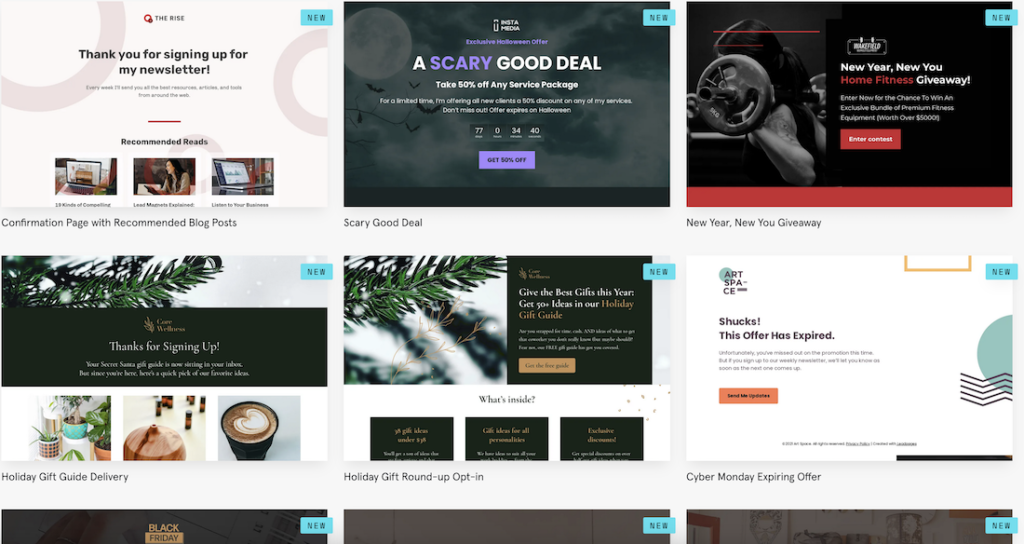
We already saw that Clickfunnels beats Leadpages in terms of features and functionality. The folks behind Leadpages probably know this and don’t even try to compete with Clickfunnels on that level.
Instead, they carved out a niche for themselves and a loyal customer base on the back of clean, professional and beautiful looking templates.
My guess is that Leadpages just cares more about design and invests more into it. It’s sort of their competitive edge. Clickfunnels, on the other hand, cares more about conversions, sales and helping people make money.
Both Clickfunnels and Leadpages have a tremendous amount of pre-built templates to pick from, but Leadpages wins hands down if these templates were presented during a design contest.
That being said, if you take one of the newer sales funnel templates in Clickfunnels and adjust it to your needs, you can have a really awesome looking landing page or funnel.
You can “steal” these five custom sales funnels from my own business, some of which are built using the Mother Funnel templates and others I designed and built myself from ground up (without any design or coding skills).
If I had to give Clickfunnels or Leadpages an award for “best designed templates”, it would definitely go to Leadpages though.
Clickfunnels vs Leadpages? The winner here is clear for me.
Winner: Leadpages
5. Community.
Another often overlooked aspect of software is the community and the people using these tools.
Let’s compare Clickfunnels vs Leadpages in terms of community.
After all, when you’re buying into a software you’re not only purchasing a set of “code” but a culture, philosophy and community.
Clickfunnels:
Clickfunnels has a huge Facebook group which can be helpful and an inspiring place to hang out. They do a lot for the community in general. They have a podcast (which I was featured in a few years ago) and a lot of “gurus” in the industry use Clickfunnels.
Another thing that Clickfunnels has going for itself is a well-known and charismatic CEO, Russell Brunson. He has a YouTube channel, pushes out a lot of content and people just know and recognize him.
Clickfunnels also hosts Funnel Hacking Live, probably the go-to marketing live event in the world. I’ve never been to the event but it’s one of the main networking events of the industry.
Given all these points, I must say that Clickfunnels has built an incredibly strong community. It can almost be described as being slightly “cultish”, both in a good and bad way. In a good way, because Clickfunnels has produced a lot of millionaires and there are a lot of people who are inspired and believe in Clickfunnels’ mission.
And also in a bad way because when you become the industry leader like this, it also attracts some shady folks. If you’re not careful, you might get ripped off in the ClickFunnels Facebook group by so called “funnel designers” happy to take your money and never delivering you with the finished product.
One thing I love about Clickfunnels is their “2 Comma Club Awards”. I personally received mine in 2021, after scaling one of my coaching programs to the million dollar mark.

It hangs on my wall, feels good and definitely has some level of prestige in the industry.
Leadpages:
Leadpages has a YouTube channel and Facebook group with 18,000+ members.
I believe their community is a bit less hyped, which isn’t bad.
I’m not aware that they have any awards for customers and clients that reach certain milestones in their business.
And although I do suspect they do some sort of live events, I haven’t really heard of them or attended any. It’s likely that their community is more comprised of “regular” people and business owners while Clickfunnels attracts more the type of business owner and marketer than wants to make money fast and as much as possible.
Leadpages probably has a more grounded culture while Clickfunnels could appear to the outsider as a bit over the top and salesy. This might also be a side effect of Clickfunnels’ explosive growth though. They simply have a much bigger customer base and attract a wider audience.
But overall, when it comes to community, I think Clickfunnels wins this one.
Winner: Clickfunnels
6. Clickfunnels vs Leadpages: Pricing.
We’ve compared a lot of different things already. But we haven’t talked about one of the most important topics yet: Pricing. Who is the winner in terms of pricing in the battle between Clickfunnels vs Leadpages?
Let’s compare Clickfunnels and Leadpages in terms of pricing and affordability.
As you know by now, both tools have a basic and advanced plan.
Clickfunnels:
Clickfunnels costs $97 a month for the basic plan.
It’s the plan I was on for almost 8 years before upgrading to Clickfunnels Platinum.
If you want unlimited funnels, pages and traffic as well as access to the email marketing platform and affiliate management tool, you can upgrade to platinum just like I did for $297 a month.
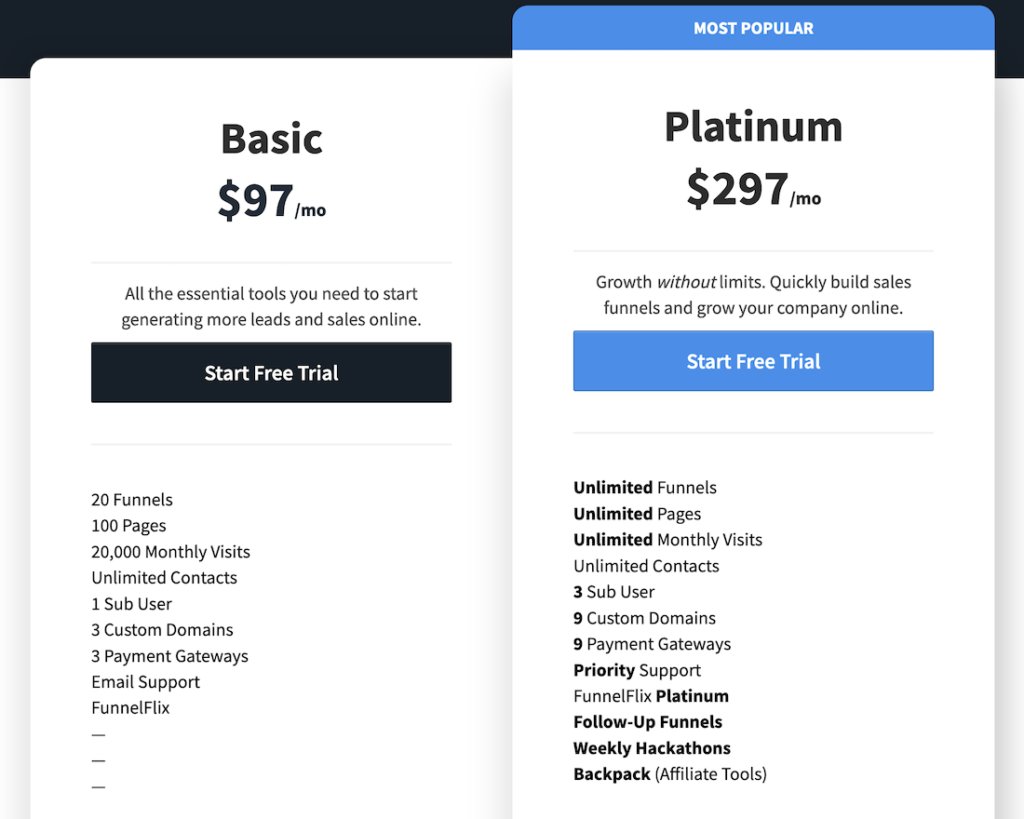
This might seem like a lot, but if you consider that you can get rid of most other tools and treat Clickfunnels as an investment it’s really not that much.
Relative to what you’re saving and what you can make with the tool, I consider Clickfunnels as one of the most important tools in my software stack and one of the best investments I’ve made.
I have paid them $97 a month since 2014 which is kind of crazy. I’ve definitely been good business for them. Overall, I paid them $9,312 in the last decade. But during that time I used Clickfunnels to make millions of dollars in online sales.
I’m not saying you’ll do the same. Individual results obviously vary and this required a lot of hard work, but I believe a tool that has the potential to generate money should be treated differently than a tool that is just a downright expense.
Get started with Clickfunnels.
Leadpages:
Leadpages costs $47 a month for the basic plan.
This is about half the price of Clickfunnels, but you also get significantly less features. Most importantly, the ability to process sales and host checkout forms and pages is missing in Leadpages’ lite plan.
Leadpages Pro costs $97 a month, which is the same amount that the basic plan of Clickfunnels costs.
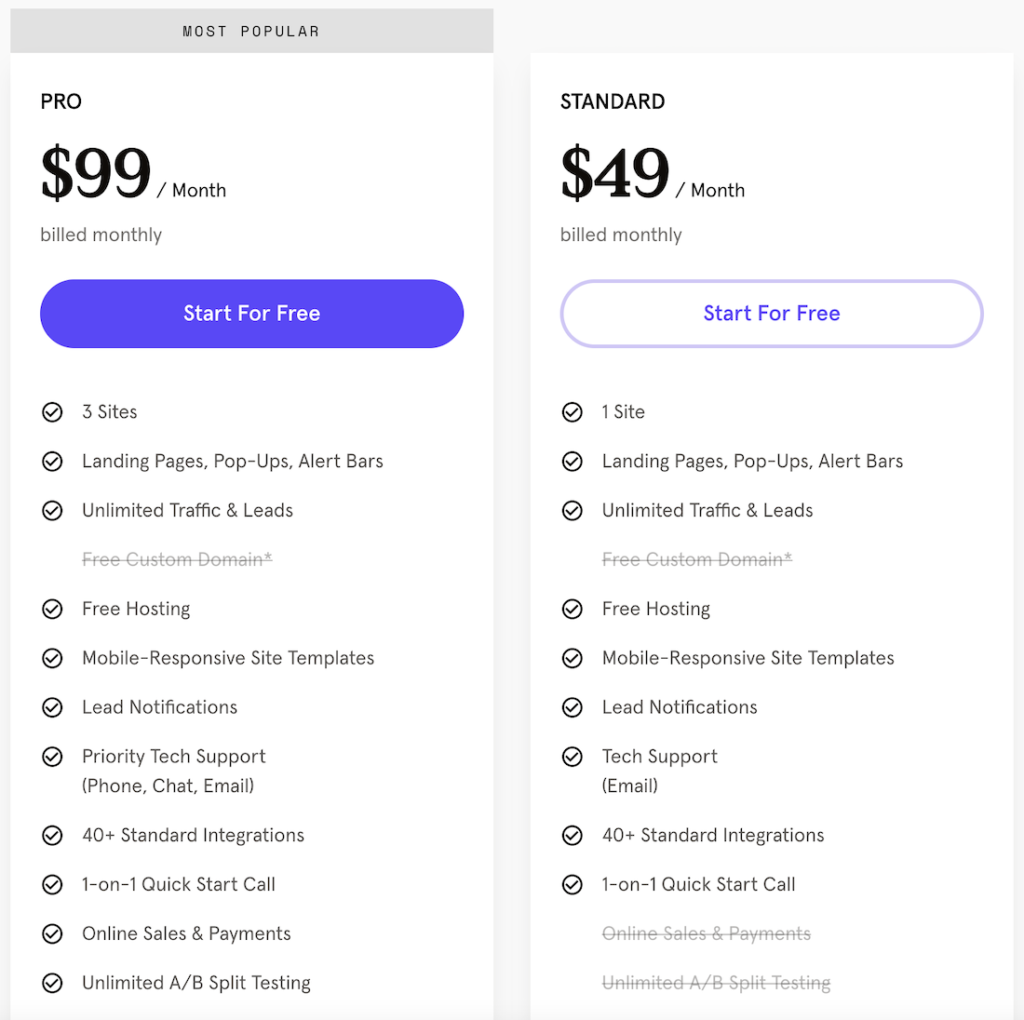
Again, I wouldn’t look at any of these tools as just an expense but as a potential investment into your business that hopefully pays for itself at some point.
If all we look at is pricing, while ignoring features and functionality and the potential of each tool to grow your business, Leadpages wins this round. But it’s nevertheless important not to look at pricing in an isolated way.
It’s always about value and not about price.
If you’re on a tight budget, Leadpages definitely offers more attractive pricing. Their basic plan is half the price of Clickfunnels. And their Pro plan is three times cheaper than Clickfunnels Platinum.
Clickfunnels vs Leadpages? When it comes to pricing, Leadpages wins.
Winner: Leadpages
Get started with Leadpages.
Clickfunnels Pros and Cons.
Pros:
- All-in-one marketing tool
- Includes payments and checkout forms on all plans
- Intuitive, fast and customizable page editor
- Ability to build full sales funnels with 1-click upsells and down-sells
- Affiliate management tool
- Email marketing and broadcasts
- Funnel share & imports (amazing feature!)
- Funnel Marketplace
- Thriving community
- Industry-leading live event
- Awards
Cons:
- Not the cheapest option on the market
- Monthly visitor, funnel and page limitations on basic plan
- Pre-loaded template designs could be more beautiful
- Occasional but rare bugs
Leadpages Pros and Cons.
Pros:
- Cheaper
- Pre-loaded with beautiful designs
- No monthly visitor limitations on basic plan
- Great for list building and lead generation
- Popups and alerts
- Some cool features like Leadmeter and Expert Feedback
Cons:
- No ability to process sales or host checkout forms and pages on basic plan
- Basic plan can only be used as website or lead generation tool
- Page builder broke with my ad blocker on
- Pro plan has way less features than Clickfunnels Platinum
Wrap Up
The big battle between Clickfunnels vs Leadpages is over. Who is the winner? As always, that depends on your goals and what you need.
If you’re just looking for a tool to build beautiful landing pages to grow your email list and generate leads, I’d say you’re better off using the basic version of Leadpages. You’ll save some money and have everything you need.
If you’re looking for especially beautiful templates and want an awesome looking website, eye-catching landing pages and elegant sales pages with the ability to collect payments, Leadpages Pro is perfect for you.
But if you’re primarily looking for a tool that can help you make money and sell stuff online and you’re not super concerned about design and appearance, I believe Clickfunnels is probably better suited due to having more selling-related functionality.
As for Clickfunnels Platinum, is it worth it? For most of the last 8 years I would have said “no”. The truth is, I made a lot of money using just the basic version of Clickfunnels.
If you already have an email marketing provider and don’t plan to use affiliates to promote your offers, I recommend going with the regular Clickfunnels plan. You can easily integrate it with Mailchimp or some other email marketing tool. And as I said, if you don’t need affiliates it’s not a problem and you can always sign up for a third-party affiliate management software if you need to.
But if you’re looking for an all-in-one marketing platform and you want everything in one place, and you don’t want to juggle multiple tools, I recommend straight away signing up for Clickfunnels Platinum.
If you consider the fact that you don’t need some other tools, and are expecting to make money through Clickfunnels, it’s a reasonable investment and you probably barely need any other tool in your business.
